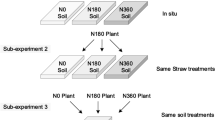Summary
Proximity of new wheat straw residues to sown wheat seed has an effect on germination, plant growth and ultimate yield. Decomposition of wheat straw may produce toxins or it may cause immobilization of nitrogen in, or applied to the soil.
In pot experiments, it has been shown that germination of wheat was depressed when large amounts of straw were decomposed on the surface for up to 18 days; after 54 days it had no effect on germination. Immobilization of nitrogen occurred mainly when the straw was mixed with the soil, or when surface-rotted straw was ploughed into the soil just before seeding. The latter effect could not be overcome by the addition of mineral nitrogen.
Similar content being viewed by others
References
Broadbent F. E. and Nakashima T., Plant recovery of immobilized nitrogen in greenhouse experiments. Soil Sci. Soc. Am. Proc. 29, 55–60 (1865).
Greenwood E. A. N. and Kimber R. W. L., Inhibition of germination and root growth by extracts of Bromus mollis L. straw. Field Stn. Record 6 (I), 55–60 (1967).
Jansson S. L., Nitrogen transformation in soil organic matter, In The Use of Isotopes in Soil Organic Matter Studies. Pergamon Press, New York (1963).
Kimber R. W. L., Phytotoxicity from plant residues. I. The influence of rotted wheat straw on seedling growth. Australian J. Agr. Research 18, 361–374 (1967).
Kimber, R. W. L., Phytotoxicity from plant residues. II. The effect of time of rotting of straw from some grasses and legumes on the growth of wheat seedlings. Plant and Soil (in press) (1973).
Kononova M. M., Soil Organic Matter, p. 360. Pergamon Press, London (1966).
McCalla T. M. and Army T. J., Stubble mulch farming. Adv. Agron. 13, 125–196 (1961).
McCalla T. M. and Haskins F. A., Phytotoxic substances from soil microorganisms and crop residues. Bacteriol. Rev. 28, 181–207 (1964).
Myers H. E. and Anderson K. L., Brome grass toxicity vs nitrogen starvation. J. Am. Soc. Agron. 34, 770–773 (1942).
Northcote, K. H., A factual key for the recognition of Australian Soils. 2nd Ed. CSIRO, Div. of Soils Report 2/65 (1965).
Parberry, N. H. and Swaby, R. J., Organic materials in supplying nitrogen to crops. Agr. Gaz. New South Wales No. 3232 (1942).
Patrick Z. A. and Koch L. W., Inhibition of respiration, germination and growth by substances arising during the decomposition of certain plant residues in soil. Can. J. Botany 36, 621–627 (1958).
Patrick Z. A., Toussoun T. A. and Koch L. W., Effect of crop-residue decomposition products on plant roots. Ann. Rev. Phytopathol. 2, 267–292 (1964).
Russell E. W., Soil Conditions and Plant Growth. pp. 240–263. John Wiley and Sons, New York (1962).
Author information
Authors and Affiliations
Additional information
Part II, Plant and Soil 38, 347–361 (1973).
Rights and permissions
About this article
Cite this article
Kimber, R.W.L. Phytotoxicity from plant residues. Plant Soil 38, 543–555 (1973). https://doi.org/10.1007/BF00010694
Received:
Issue Date:
DOI: https://doi.org/10.1007/BF00010694




